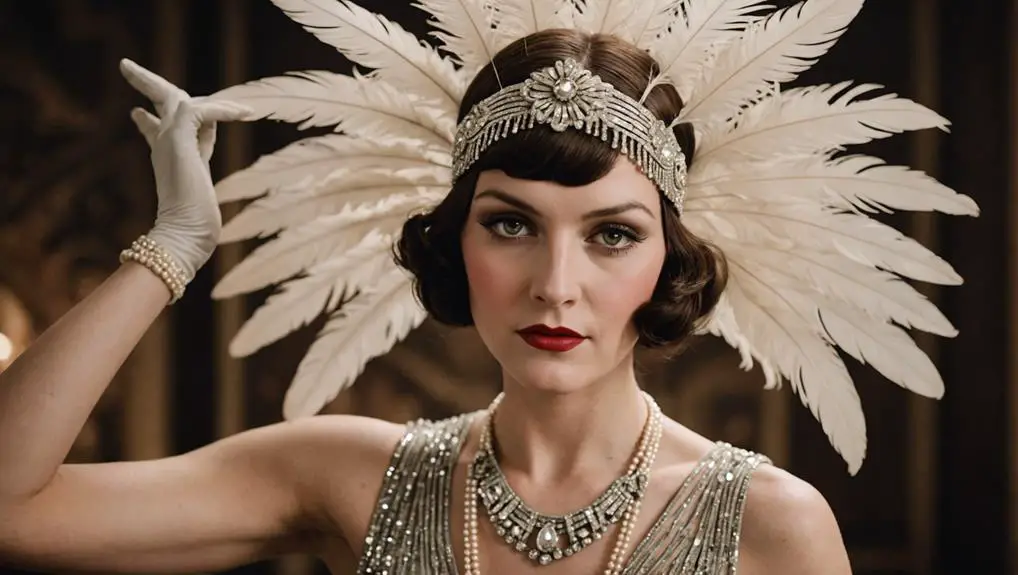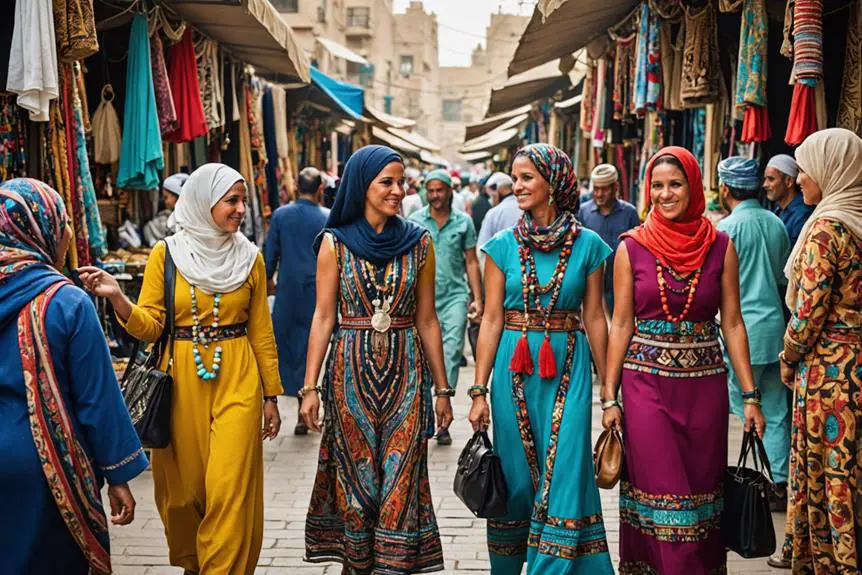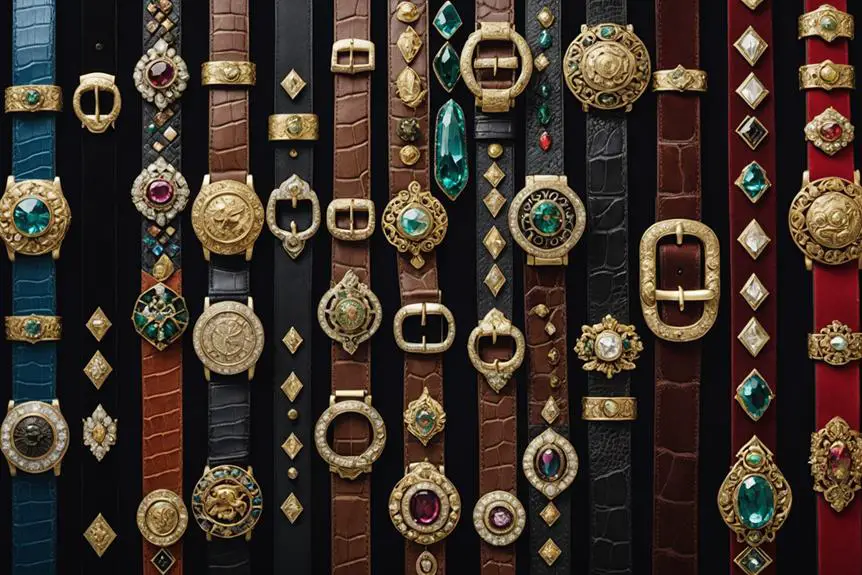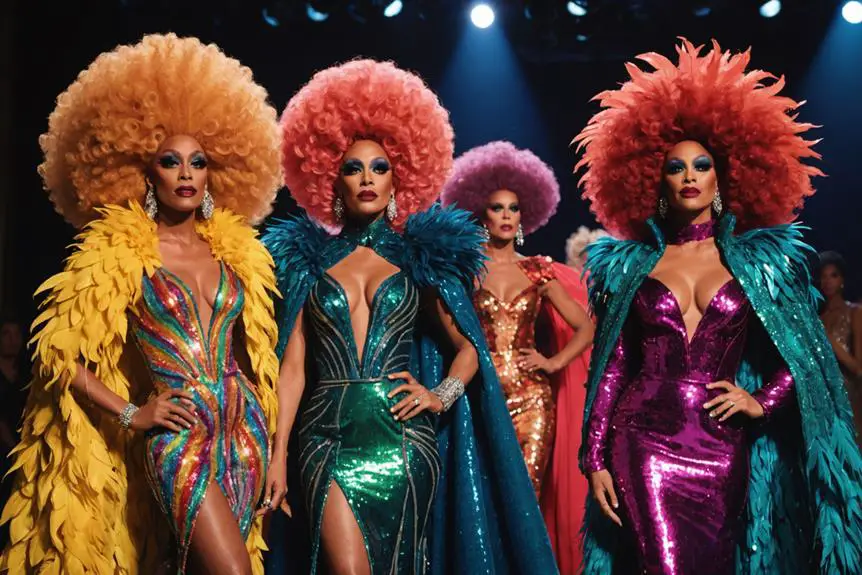In the 1930s, women's flapper headpieces became symbols of liberation and modernity. You'd notice cloche hats framing bobbed hairstyles, often embellished with feathers, sequins, and chic beading. These accessories reflected the vibrant spirit of the Jazz Age and the cultural shifts surrounding women's roles. Influenced by Hollywood glam and social events, headpieces were not just fashion items; they embodied individuality and creativity. The intricate craftsmanship showcased through luxurious materials like silk and velvet made each piece unique. If you explore further, you'll uncover how these fashionable statements shaped an entire era and their ongoing significance in style.
Historical Context of Flapper Headpieces
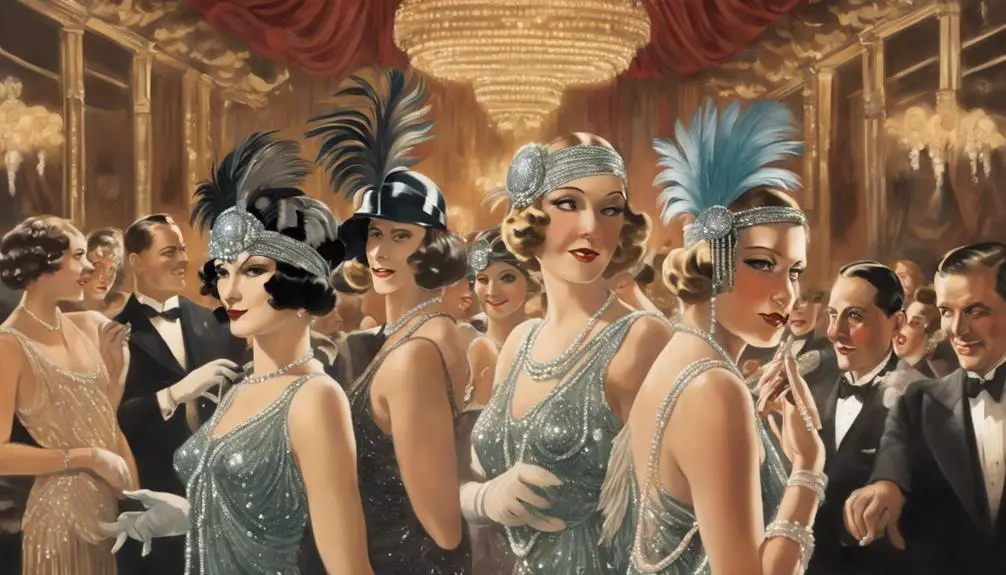
The flapper headpiece's design and popularity during the 1930s offer a fascinating glimpse into the cultural shifts of the era, marking a pivotal moment in women's fashion and social liberation. The rise of the flapper movement brought forth a new sense of independence and modernity, reflected in the bold choices women made in their accessories. Flapper headpieces, often adorned with feathers, sequins, and intricate beading, embodied the exuberance of the Jazz Age and the carefree spirit of the Roaring Twenties.
With the popularity of short bobbed hairstyles, closer-fitting headpieces like cloche hats and decorative bands gained traction, allowing women to express their newfound freedom. These accessories not only complemented the fashion of the time but also echoed the artistic movements like Art Deco, showcasing geometric shapes and detailed craftsmanship. Social events, including jazz clubs and dance halls, played a critical role in popularizing these headpieces, as they seamlessly blended with the lively atmosphere and the essence of flapper culture. Through these designs, women embraced a sense of liberation that transcended mere fashion, making a powerful statement about their roles in society during a transformative decade.
Iconic Styles of the 1930s
During the vibrant 1930s, flapper headpieces emerged as iconic symbols of women's evolving fashion and identity. Central to this era was the cloche hat, a close-fitting bell-shaped accessory that beautifully framed the short bobbed hairstyles favored by flappers. This style wasn't just about aesthetics; it represented a shift towards modern femininity, allowing women to embrace their independence and newfound social freedoms. The intricate designs and craftsmanship of these headpieces often reflected the unique characteristics of vintage fashion, as many pieces included elements typical of the era's accessories, such as vintage clothing labels that indicated their authenticity and craftsmanship.
Headpieces of the 1930s featured bold embellishments like feathers, sequins, and beads, reflecting the lively spirit of the Roaring Twenties. These decorative elements weren't merely for show; they served functional purposes by enhancing outfits for social events, particularly jazz parties and speakeasies. Vintage pieces, such as the black velvet flapper girl hat and the rare triple black bead fishnet hat, became highly sought after, showcasing unique designs and exceptional craftsmanship.
As you explore these iconic styles, it's clear that flapper headpieces were not only fashionable but also emblematic of a cultural revolution. They celebrated women's liberation, transforming how society viewed femininity during a time of significant change and exuberance.
Materials and Embellishments Used
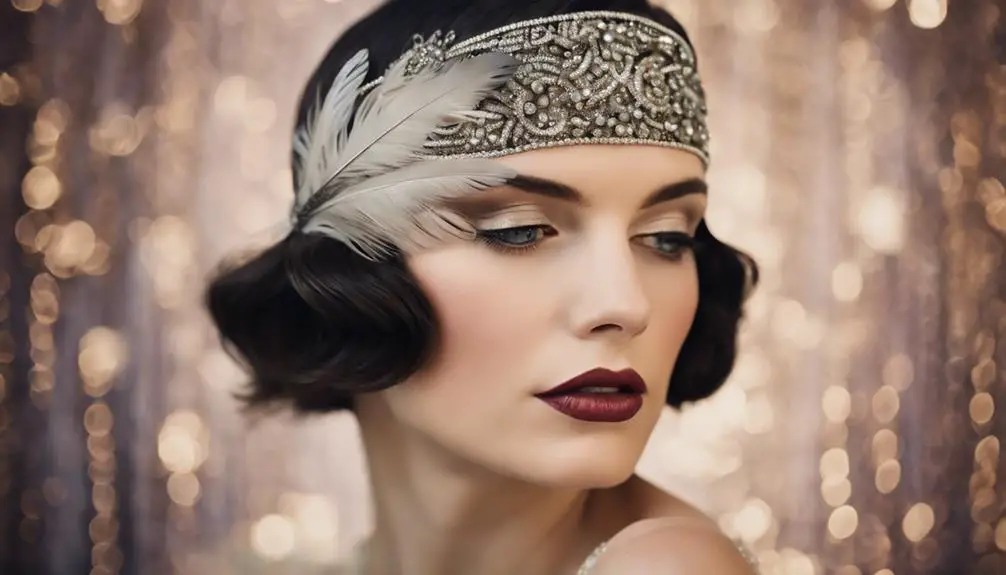
Amidst the glamour of the 1930s, flapper headpieces showcased an exquisite blend of materials and embellishments that epitomized the era's opulence. You'd often find luxurious fabrics like silk, velvet, and satin, chosen for their elegant appearance and soft texture. These materials not only spoke to sophistication but also provided a plush backdrop for the dazzling embellishments that defined the style.
Feathers, sequins, and beads were frequently incorporated, adding layers of glamour and sparkle that caught the light beautifully. Rhinestones adorned many pieces, enhancing their visual appeal and highlighting the craftsmanship of skilled milliners. Floral appliqués brought a touch of nature's beauty into the design, creating a harmonious balance between elegance and whimsy.
Vintage lace and netting played a crucial role, offering a delicate touch that often formed veils or overlays, complementing the overall aesthetic. Additionally, headpieces were versatile accessories, often adorned with brooches or pins, allowing you to customize them to match specific outfits and personal styles. This thoughtful combination of materials and embellishments made each flapper headpiece a unique statement piece that encapsulated the vibrant spirit of the 1930s.
Cultural Influences on Fashion
Cultural influences profoundly shaped the fashion of the flapper era, as women embraced new roles and sought to express their individuality through daring styles. The 1920s marked a significant shift in societal norms, with flappers symbolizing independence and rebellion through their fashion choices, particularly their headpieces. This evolution stemmed from several key cultural movements:
- Suffragette Movement: The fight for women's rights empowered flappers to adopt bold styles that represented freedom, including short hair and decorative headpieces.
- Jazz Music: The lively rhythms of jazz inspired extravagant designs, as flappers adorned themselves with headpieces that matched the vibrant nightlife of speakeasies and dance halls.
- Hollywood Glamour: Film stars of the era set fashion trends, leading women to emulate the glamorous headpieces showcased on screen, intertwining cinema with everyday life.
As these influences converged, flapper headpieces became more than mere accessories; they reflected the spirit of the Roaring Twenties. Through feathers, beads, and sequins, these designs encapsulated the essence of independence, creativity, and cultural transformation that defined the era.
Evolution of Women's Headwear
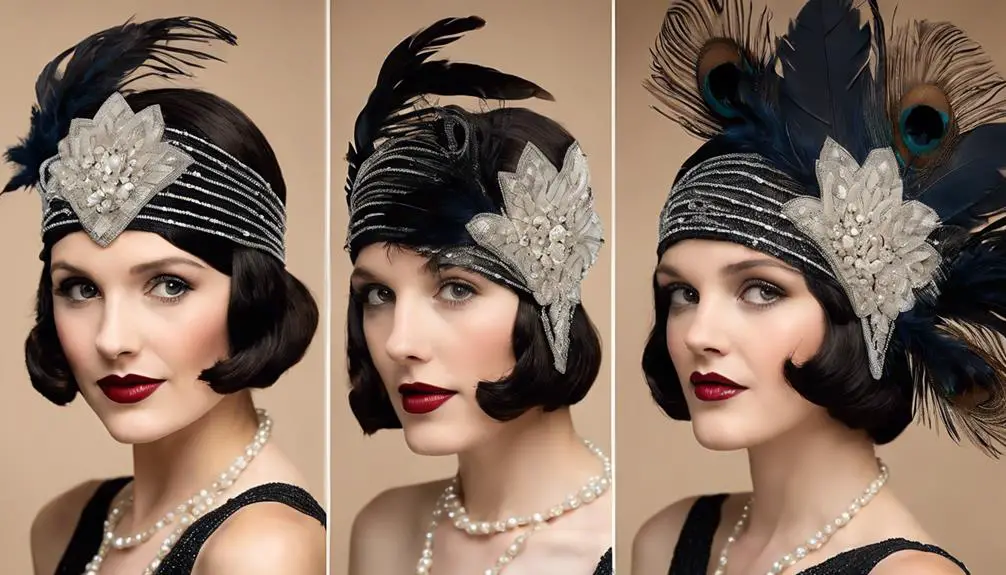
As women's roles transformed in the 1920s and 1930s, headwear evolved dramatically to reflect this new sense of freedom and individuality. The shift from extravagant large hats to the sleek cloche marked a significant change in women's fashion. Cloche hats, characterized by their bell shape and snug fit, became synonymous with the flapper movement, embodying the liberation women felt during this era. You'd often see these hats paired with bobbed hairstyles, creating a cohesive and stylish look. This period also saw an interest in vintage clothing labels, as women began to appreciate the history and craftsmanship behind their fashion choices, adding an extra layer of significance to their accessories. The emergence of vintage tag identification allowed for a deeper understanding of the garments and accessories, enhancing their connection to the past.
During the Roaring Twenties, headpieces gained popularity, often adorned with luxurious embellishments like feathers, beads, and sequins. These decorative elements not only enhanced the hats' glamour but also allowed women to express their unique styles. The rise of jazz culture and social dancing inspired the creation of smaller, more intricate headpieces, perfect for showcasing individuality at events.
Moreover, advancements in millinery made stylish options more accessible, allowing women from various social classes to embrace fashionable headwear. This evolution of women's hats reflected broader cultural changes, signaling a departure from traditional constraints and inviting a new era of self-expression and confidence.
Popularity of Cloche Hats
The rise of cloche hats marked a significant moment in women's fashion during the 1920s and 1930s, capturing the spirit of the flapper movement. These close-fitting, bell-shaped hats became a defining symbol of the Roaring Twenties, perfectly complementing the era's bobbed hairstyles. As you explore the popularity of cloche hats, consider their profound influence on women's fashion:
- Material Diversity: Cloche hats were crafted from felt, wool, and velvet, showcasing a range of textures that appealed to women's tastes.
- Decorative Elements: Many featured intricate embellishments like ribbons, sequins, and floral designs, adding a unique flair that resonated with the flapper style.
- Cultural Shift: The cloche hat reflected a broader cultural move towards modernity and liberation in women's attire, symbolizing a break from traditional norms.
As you admire vintage cloche hats today, it's clear they remain highly sought after collectibles. Their enduring presence in fashion history speaks to their significance during a transformative era for women, illustrating how style can encapsulate a cultural moment.
Unique Vintage Designs
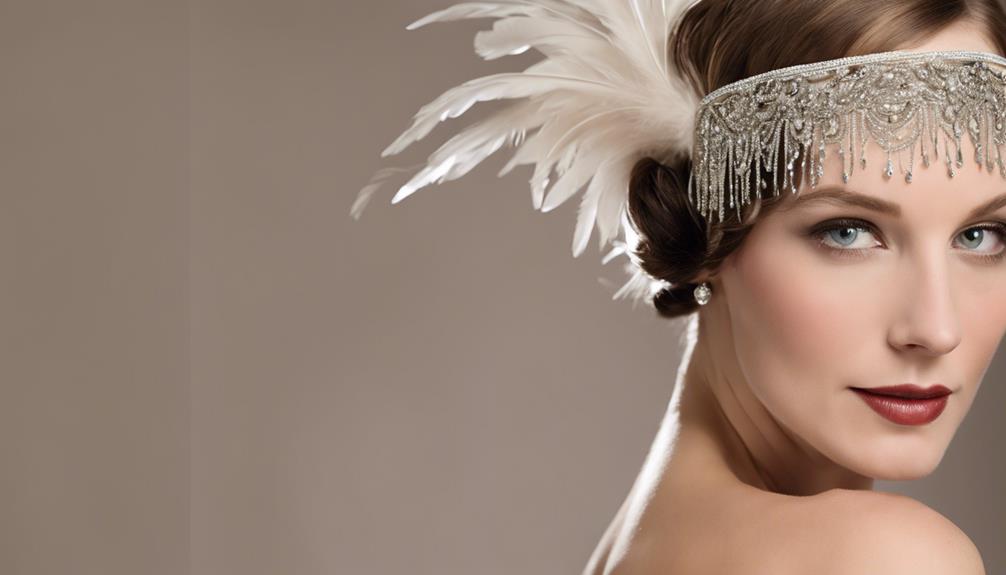
Flapper headpieces from the 1930s showcase a stunning array of unique vintage designs that encapsulate the era's glamour and creativity. Each piece, whether it's the Vintage Black Velvet Flapper Girl Hat or the Black Velvet Cloche Hat, reflects a commitment to intricate craftsmanship. You'll find that many headpieces feature decorative elements like Antique Feather Plumes VTG and sequins detail floral beauty, highlighting the luxurious materials favored by flapper fashionistas.
Take, for instance, the Rare Vintage 30s-40s Triple Black Bead Fishnet Flapper Hat, which stands out as a collector's dream with its opulent design and meticulous beadwork, priced at $598.00. Meanwhile, more accessible options like the Flapper Black Velvet Womens and the Flapper Brown Velvet Feather offer a taste of this unique style without breaking the bank.
The Cloche Hat with Bow and Vintage Wool Satin Hat also exemplify how these designs were tailored to enhance bobbed hairstyles, symbolizing the significant shift in women's fashion during this vibrant era. Overall, these unique vintage designs not only serve as headwear but as statements of individuality and sophistication in 1930s fashion.
Collecting Vintage Headpieces
Collecting vintage headpieces offers enthusiasts an exciting journey into the rich history and artistry of the 1930s. These exquisite accessories, particularly flapper headpieces, symbolize women's liberation during the jazz age, showcasing unique materials like feathers, beads, and sequins. As you explore this enthralling world, consider these key aspects:
- Condition Matters: Headpieces in good condition with intact decorative elements are highly sought after. This greatly influences their market value.
- Diverse Sources: Online auction platforms and vintage fashion communities are treasure troves for collectors, providing access to rare and unique pieces that can elevate any collection.
- Preservation Practices: Proper care is essential for maintaining the beauty of vintage headpieces. This includes careful cleaning, avoiding direct sunlight, and using appropriate storage methods.
Fashion Trends and Social Events
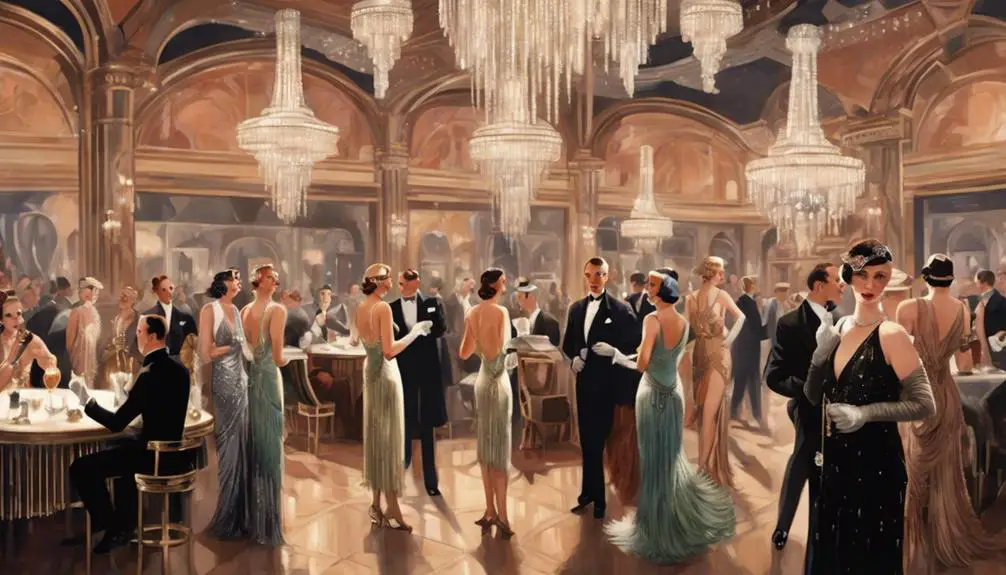
Amidst the vibrant social scene of the 1930s, fashion trends flourished as women embraced their independence and self-expression. Flapper headpieces became iconic, characterized by bold embellishments of feathers and sequins that reflected the era's glamorous spirit. Social events like jazz clubs and speakeasies played a pivotal role in popularizing these styles, where women sought to assert their newfound freedom through fashion choices.
Cloche hats dominated the fashion landscape, often complemented by coordinating headpieces that elevated the overall look. This synergy between headwear and clothing allowed flappers to showcase their personalities, making statement pieces essential for any social gathering. The influence of Hollywood was undeniable; film stars flaunted extravagant headpieces on screen, setting trends that resonated with women enthusiastic to embody modern femininity.
As participation in social activities surged, so did the demand for fashionable yet functional headpieces. This led to a notable increase in the variety and production of flapper accessories available on the market. Ultimately, these fashion trends not only reflected the changing roles of women but also marked a significant cultural shift towards liberation and self-identity in the 1930s.
Frequently Asked Questions
What Did Flapper Girls Wear on Their Heads?
You'd find flapper girls wearing stylish hats and decorative headpieces, like cloche hats and feathered fascinators. These accessories complemented their bobbed hairstyles, adding a glamorous touch to their overall playful and extravagant looks.
Why Did Flappers Wear Cloche Hats?
Flappers wore cloche hats to symbolize their modernity and independence. These close-fitting hats complemented their bobbed hairstyles, reflecting a youthful rebellion against traditional femininity while showcasing their extravagant lifestyles through embellishments and fashionable designs.
What Were Women's Hats Called in the 1930s?
In the 1930s, women's hats were primarily called cloche hats, featuring a close-fitting, bell shape. Other popular styles included flapper hats and pillbox hats, each reflecting the era's vibrant fashion and social changes.
Which Women's Hat Was Popular in the 1920S and Continued to Be Worn in the 1930S With Some Modifications?
You'll find the cloche hat was immensely popular in the 1920s, continuing into the 1930s. Its evolution included decorative elements, showcasing the period's feminine style while adapting to changing fashion trends and materials.
